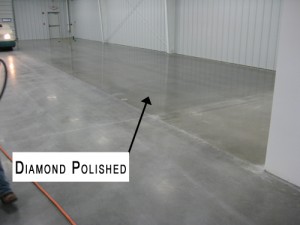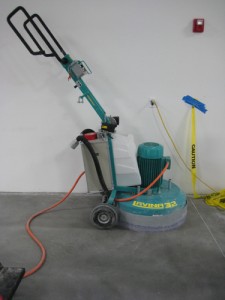Diamond Polishing Concrete Slabs
Polished Commercial Building Slabs
 We are completing a 36,000 sq. ft. commercial building for a client and on of the exciting new construction techniques that we’re using is diamond polishing of the slab. Traditionally a large building like this would have the slab coated with an epoxy finish to protect the slab from liquid spills and traffic. However, another alternative is gaining popularity and that’s the use of diamond polishing.
We are completing a 36,000 sq. ft. commercial building for a client and on of the exciting new construction techniques that we’re using is diamond polishing of the slab. Traditionally a large building like this would have the slab coated with an epoxy finish to protect the slab from liquid spills and traffic. However, another alternative is gaining popularity and that’s the use of diamond polishing.
Diamond polishing is a fantastic way to treat a new or old slab to protect it from day to day abuse. The process involves grinding and polishing the slab with several different grits until the surface is extremely smooth and hard. As you can see in the photo the surface becomes very shiny and looks like it’s been sealed with a shiny material.
How To Polish Concrete Slabs
 Polishing concrete slabs is done by using a large floor poslisher that has diamond impregnated sanding discs. The photo shows a 20 HP Lavina 32 SPS Concrete Floor Polisher that’s being used on our project. Lavina polishing machines are planetary movement machines featuring 6 heads. The planetary motion results from the friction between the tools and the floor, which allows the tools to spin either clockwise or counterclockwise. This way the tool will not force itself against the surface’s resistance.
Polishing concrete slabs is done by using a large floor poslisher that has diamond impregnated sanding discs. The photo shows a 20 HP Lavina 32 SPS Concrete Floor Polisher that’s being used on our project. Lavina polishing machines are planetary movement machines featuring 6 heads. The planetary motion results from the friction between the tools and the floor, which allows the tools to spin either clockwise or counterclockwise. This way the tool will not force itself against the surface’s resistance.
The floor get’s polished with several different grits. After the first rough grinding a concrete densifier is applied to the surface of the concrete. The densifier is one of several commercially available products such as sodium silicate (or a related silicate or siliconate).
This is applied to the floor to densify, or harden, the concrete. The solution is absorbed into the concrete matrix, filling the pores. Chemically, the silicate reacts with the calcium hydroxide in the concrete to produce calcium silicate hydrate. Sodium silicate is the most common hardener. Potassium silicate, lithium silicate, and various siliconates are also used. After the silicate infuses into the concrete, it crystallizes in place. Then the polishing continues.
Polishing continues until the specified “sheen” is reached. Most applications are polished to a minimum of 800 grit and a maximum of 3000 grit! The final step for our floor was the application of a concrete sealer which was then burnished into the slab. This provides a very good sealer to help prevent stains from oils and lubricants that might be used in the manufacturing facility.
Cost and Benefits To Polish Concrete Floors
Polishing concrete floors or slabs makes sense for several reasons. The cost of polished concrete floors ranges from $2/sf to $4/sf. The range depends on how smooth the surface finish will be and if any stains or colorings are used. For our project the cost was about $2.35 per sq. ft. This is pretty good when you consider most epoxy coatings run $1/sf to $3/sf.
The benefits of a polished concrete floor are fairly obvious. Polished concrete floors require little to no maintanance whereas floors with coatings require regular maintanance and re-application. The other big benefit to using a polished floor is the elimination of potentially dangerous chemicals. By eliminating paints and epoxies we’re providing a much “greener” option.













This is a very timely post. We are building a new home and it will have concrete floors throughout with radiant heating. I actually love stained concrete.
Recently we heard about the diamond polishing, but don’t know much about it. Do you have any info on how staining or coloring affects the cost?
@ Alison – I’m not really sure what the cost impacts are because we’re doing such a large job. I’m sure there are folks in your area doing this that can give you some budget numbers for planning purposes. What amazes me is how much traction the concrete has after this process. It’s not slippery at all. Good luck!
Costs for the diamond-grinding floor polishing process would be worth it in the long run. Not only do you densify during the early stages, but once it is brought up to 800, the stain has already been applied to the concrete floor, prior to the actual shine. Then the 800. Polished diamond-grist may go as high as 3000. Following this step, the floor gets burnished, cleaned scrubbed, so as there is no dry concrete dust streaked upon the floor, and finally sealed. Advantages; Non-Slip Surface(safety issues, lawsuit prevention), Stain Resistant, Low Maintenance(no chemicals required to clean), gives a Show-Room Shine, hardens the concrete for longevity. The process requires patience, and the final results are well worth it.
just a little insight for those considering!
I agree with Alison – very timely post. I’m a residential builder, and I’m really interested in concrete floors. I’ve been experimenting with different types of finishes such as acid stains, floor paints, epoxies, etc. I’ve had several failures with the acid stains because the concrete surface was too soft. After staining and sealing, it chipped and scratched.
I thought I had heard of densifiers, but wasn’t sure. This really helped.
Questions: The floors at Home Depot and Lowe’s in my area seem to be polished concrete. Do you know whether they are polished concrete or is the surface I’m seeing an epoxy coating? Also, do you know whether floors can be acid stained after they’ve had densifiers applied?
@ Bill – Home Depot, Lowes, Sams Club, all of these large retail buildings are now using polished concrete. However, most of them are only paying about $0.99 per sq ft which results in a floor that is only polished to 800 grit. Even so you can see the durable finish that they achieve. I’ll ask the floor guys today if I think of it but I’m fairly sure the stain would go on after the densifier just before the final polishing happens.
A really practical and informative article! Thank you Todd.
Diamond polishing really has its advantages. Did you use diamond cup wheels in the coarser grinding procedures prior to the diamond polishing? The “diamond impregnated sanding discs” you say means diamond polishing pads, right?
I’ve followed you on Twitter, and will often visit your blogs.
Wow, so much work! Who would have thought that sanding would be this exhausting?! The floors look FANTASTIC.
Thanx for the great article. What are they doing with the dust/grindings? Most production terrazzo jobs use a dry vacuum system with hepa for the initial grinding, then switch to wet grinding for the fine grind.
Even with the hepa filters the dust is pervasive and you should count on a dusty building.
Wet grinding can cause water damage to gypsum walls so it is best to grind before drywall erection. Also the tailings are super slippery when wet, so we always put up warning signs.
@ Wells – The floors were done with a dry grinding first with a hepa vacuum attached followed by wet grinding. A commercial floor washer (like a Zamboni) was used to clean up the wet tailings. There was no damage to the drywall system. All and all the job went amazingly well and the final product is stunning!
Thanks for the article. We polish concrete in the midwest and I believe we are in the educational stages of polished concrete. People are having a hard time believing you can achieve such a sheen without a coating.
What company in the Mid-West?
Hi, Todd,
I am a concrete lover currently renovating my own studio in an 1960s inside-outside concrete condo. Polished shining finish will be the best but I accept the traditional naked concrete or cement finish simply like the one seen in school classrooms or home depot. My researches turn out that this finish can be more expensive and complicated than tile or hardwood, which doesn’t make sense to me. Hopefully I can get your advices. Many thanks in advance.
1. Is it possible to DIY considering rental tool availability, noise and dust level which may disturb my neighbours, and requirements on skills?
2. I will remove the existing laminate floor. The concrete is a bit rough. Some local contractor told me it needs to be coated / primed before polish, but he quotes $7 per sf. Do you always anyways polish the concrete directly or apply a 1/2” or so coat first and then to polish? What will be the coat material? Is self-levelling durable enough as the surface finish and can be polished?
3. For the bathroom, I like epoxy as I learnt this finish material provides water proof feature, without extra membrane underlay. Is that correct?
@ Andy –
1. Polishing concrete isn’t very noisy at all (at least my experience with the equipment I’ve seen). Most polishing is done either wet (need to clean up the slurry) or with a hepa filter vac attached. In either case it’s really not a big impact on neighbors. The skill level isn’t that bad either. I’d be surprised if you can find the equipment to rent honestly.
2. It’s always polished on the virgin concrete. No need to add more concrete. However, during the process several different sealers and hardeners are applied. $7/sf doesn’t sound outrageous if you have a small area and the concrete is fairly rough to start with.
3. Hard to say on the bathroom without seeing the room. The floor isn’t really the issue. The issue is where the water goes, floor drains, baseboard etc.
Good luck.
We recently had a new addition built onto our church and are having problems with the stained concrete floor. Apparently it had a polyurethane finish. A lot of scratches and scuffs followed and it was then waxed. We are still having problems, is diamond polishing still an option if we can remove the wax and polyurethane?
I think it’s an option…but it may take some color away.